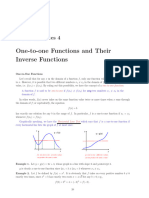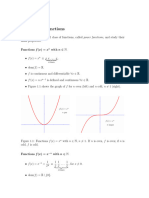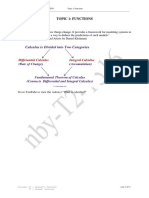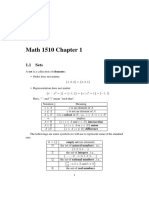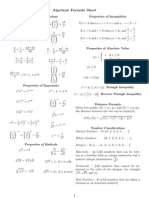Functions_3_and__-pages-3
Uploaded by
AnujanFunctions_3_and__-pages-3
Uploaded by
AnujanMathematics
1G Power functions (Self study/Homework)
Learning intentions:
To investigate the properties of key power functions whether they are:
1. even or odd functions
2. symmetrical about the y-axis or about the origin
3. increasing or decreasing over a domain
4. the key points that they pass through
The concepts of strictly increasing and decreasing functions (Extracted
from VCAA/BULLETIN No. 87 April 2011)
Key points:
1. Strictly increasing : A function f (x) is said to be strictly increasing when a < b
implies f (a) < f (b) for all a and b in its domain.
2. Strictly decreasing
A function f (x) is said to be strictly decreasing when a < b implies f (a) > f (b) for
all a and b in its domain.
3. f (x) does not need to be differentiable, or to have a non-zero derivative
for it to be strictly increasing or decreasing
1. The piecewise function g has rule:
(
(x − 1)2 + 2 0 ≤ x ≤ 2
g(x) =
2x − 1 x>2
a. Sketch its graph on the grid
y
b. State the value/s of x for which the function g is strictly increasing.
Anandakumar Arulanantham Anujan Page 11
Mathematics
c. State the value/s of x for which the function g is not differentiable.
2. The function y = f (x) is shown to the right. For what values of x is f (x):
a. strictly decreasing?
b. strictly increasing?
3. The graph of the function f (x) is shown. For what values of x is the function
y = f (x) strictly decreasing?
A. (−3, 0) ∪ (0, ∞)
B. (−3, 0)
C. (−3, 0]
D. [−3, ∞)
E. (0, ∞)
Anandakumar Arulanantham Anujan Page 12
Mathematics
Part 2. Power functions with positive integer indices such as:
f (x) = x, f (x) = x2 , f (x) = x3 , f (x) = x4 , . . .
1. Sketch the graphs of f (x) = x, f (x) = x2 , f (x) = x3 , f (x) = x4 on the same set of
axes. Clearly mark the key points of intersections with coordinates.
2. Fill in the following table by observing the graphs you have drawn above.
When n is an When n
odd positive in- is an even
teger positive
integer
Odd or even function?
Over what interval(s) is the function strictly in-
creasing or decreasing?
One-to-one?
Key point(s) the graphs pass through?
Part 3. Power functions with negative integer indices such as:
f (x) = x−1 , f (x) = x−2 , f (x) = x−3 , f (x) = x−4 , . . .
a. Sketch the graphs on the same set of axes. Clearly mark the key points.
b. Fill in the following table:
Anandakumar Arulanantham Anujan Page 13
Mathematics
When n is an odd neg- When n is an even
ative integer negative integer
Odd or even function?
Domain
Range
Horizontal asymptote
Vertical asymptote
1
Part 4. The function f (x) = x n , where n is a positive integer, such as:
1 1 1
f (x) = x 2 , f (x) = x 3 , f (x) = x 4 , . . .
1 1 1
1. Sketch the graphs of f (x) = x 2 , f (x) = x 3 , f (x) = x 4 on the same set of axes.
Clearly mark the key points of intersections with coordinates.
2. Fill in the following table by observing the graphs you have drawn above.
When n is an odd posi- When n is an even posi-
tive integer tive integer
Domain
Over what interval(s)
is the function strictly
increasing or decreas-
ing?
One-to-one?
Key point(s) the
graphs pass through?
Anandakumar Arulanantham Anujan Page 14
Mathematics
Part 5. Inverses of Power Functions
1. If n is an odd positive integer, then f (x) = xn is strictly increasing for x ∈ R.
2. If f is an odd one-to-one function, then its inverse f −1 (x) is also an odd function.
1. For f : R → R, where f (x) = x5 :
(a) Find the rule of its inverse function f −1 (x).
(b) Define the inverse function f −1 (x).
2. A rectangle is inscribed in a semi-circle with a radius of 10 cm. The length of the
rectangle is 2x cm.
a. Write its width in terms of x.
b. Write an equation for calculating the area, A, of the rectangle.
c. State the set of all suitable values of x given A > 0.
d. Sketch the graph of A, labeling all the key points with coordinates.
y
Anandakumar Arulanantham Anujan Page 15
Mathematics
e. Find the dimensions of the rectangle for which the area of the rectangle is
maximum and state the maximum area.
3. A rectangle is inscribed in an isosceles triangle with dimensions as shown.
a. Express the width of the rectangle, y, in terms of x.
b. Write the area, A, of the rectangle in terms of x.
c. State the domain of A(x) given A > 0.
d. Sketch the graph of the area, labeling the key points as coordinates.
y
Anandakumar Arulanantham Anujan Page 16
You might also like
- Richard Earl - Towards Higher Mathematics - A Companion-Cambridge University Press (2017)No ratings yetRichard Earl - Towards Higher Mathematics - A Companion-Cambridge University Press (2017)544 pages
- MM3&4 - Functions and Transformations Summary NotesNo ratings yetMM3&4 - Functions and Transformations Summary Notes16 pages
- Yo Sé Que Me Ama El Salvador /yo Sé Que Vive Mi SeñorNo ratings yetYo Sé Que Me Ama El Salvador /yo Sé Que Vive Mi Señor6 pages
- University of Zimbabwe: Mte 101 Engineering Mathematics 1No ratings yetUniversity of Zimbabwe: Mte 101 Engineering Mathematics 121 pages
- Inverse Relations and Inverse Functions Part BNo ratings yetInverse Relations and Inverse Functions Part B8 pages
- C01 Calculus of One Variable - T1 - 1112No ratings yetC01 Calculus of One Variable - T1 - 111251 pages
- 2v-f9x7-FlsC (278299418) - Pearson Guide To Objective Math PDF77% (56)2v-f9x7-FlsC (278299418) - Pearson Guide To Objective Math PDF957 pages
- Vertical Line Test: L1 - 1.1 - Power Functions Lesson Mhf4UNo ratings yetVertical Line Test: L1 - 1.1 - Power Functions Lesson Mhf4U8 pages
- DiagnosticTests From Stewart (Nby T1 1617)No ratings yetDiagnosticTests From Stewart (Nby T1 1617)13 pages
- General Mathematics Semi Detailed Lesson Plan Week 1No ratings yetGeneral Mathematics Semi Detailed Lesson Plan Week 112 pages
- Module 3 Mathematics in The Modern World 35846No ratings yetModule 3 Mathematics in The Modern World 3584656 pages
- Fundamentals of Mathematics Functions and Graphs by Sanjay Mishra PDFNo ratings yetFundamentals of Mathematics Functions and Graphs by Sanjay Mishra PDF642 pages
- FUNCTIONS_6bf5bb85-965f-440e-a69d-f2d2869ed80eNo ratings yetFUNCTIONS_6bf5bb85-965f-440e-a69d-f2d2869ed80e40 pages
- W6 Ex 10C Combinations and Proabability SolnNo ratings yetW6 Ex 10C Combinations and Proabability Soln12 pages
- W5 Ex 10A 10B Addition and Multiplication Principles SolnNo ratings yetW5 Ex 10A 10B Addition and Multiplication Principles Soln8 pages
- Wellington Teaching and Learning Model_writing Activities Period 4 (1)No ratings yetWellington Teaching and Learning Model_writing Activities Period 4 (1)3 pages
- W7 Working with Combinations and Permutations Formulae SolnNo ratings yetW7 Working with Combinations and Permutations Formulae Soln2 pages
- KSEEB Solutions For Class 7 Maths Chapter 2 Fractions and Decimals Ex 2.7 - KTBS SolutionsNo ratings yetKSEEB Solutions For Class 7 Maths Chapter 2 Fractions and Decimals Ex 2.7 - KTBS Solutions14 pages
- József Wildt International Mathematical Competition: The Edition XXVII, 2017No ratings yetJózsef Wildt International Mathematical Competition: The Edition XXVII, 20178 pages
- Revision Village Math Ai SL Geometry Amp Trigonometry Hard Difficulty Questionbank 3 CompressNo ratings yetRevision Village Math Ai SL Geometry Amp Trigonometry Hard Difficulty Questionbank 3 Compress27 pages
- Further Pure Mathematics Assignment 02 QPNo ratings yetFurther Pure Mathematics Assignment 02 QP50 pages
- 2023 JC2 H2 Maths Prelim St. Andrew's Junior College With AnswerNo ratings yet2023 JC2 H2 Maths Prelim St. Andrew's Junior College With Answer48 pages
- SCC Introductory Algebra Book Spring 2013No ratings yetSCC Introductory Algebra Book Spring 2013297 pages
- Richard Earl - Towards Higher Mathematics - A Companion-Cambridge University Press (2017)Richard Earl - Towards Higher Mathematics - A Companion-Cambridge University Press (2017)
- MM3&4 - Functions and Transformations Summary NotesMM3&4 - Functions and Transformations Summary Notes
- Yo Sé Que Me Ama El Salvador /yo Sé Que Vive Mi SeñorYo Sé Que Me Ama El Salvador /yo Sé Que Vive Mi Señor
- University of Zimbabwe: Mte 101 Engineering Mathematics 1University of Zimbabwe: Mte 101 Engineering Mathematics 1
- 2v-f9x7-FlsC (278299418) - Pearson Guide To Objective Math PDF2v-f9x7-FlsC (278299418) - Pearson Guide To Objective Math PDF
- Vertical Line Test: L1 - 1.1 - Power Functions Lesson Mhf4UVertical Line Test: L1 - 1.1 - Power Functions Lesson Mhf4U
- General Mathematics Semi Detailed Lesson Plan Week 1General Mathematics Semi Detailed Lesson Plan Week 1
- Fundamentals of Mathematics Functions and Graphs by Sanjay Mishra PDFFundamentals of Mathematics Functions and Graphs by Sanjay Mishra PDF
- A-level Maths Revision: Cheeky Revision ShortcutsFrom EverandA-level Maths Revision: Cheeky Revision Shortcuts
- W5 Ex 10A 10B Addition and Multiplication Principles SolnW5 Ex 10A 10B Addition and Multiplication Principles Soln
- Wellington Teaching and Learning Model_writing Activities Period 4 (1)Wellington Teaching and Learning Model_writing Activities Period 4 (1)
- W7 Working with Combinations and Permutations Formulae SolnW7 Working with Combinations and Permutations Formulae Soln
- KSEEB Solutions For Class 7 Maths Chapter 2 Fractions and Decimals Ex 2.7 - KTBS SolutionsKSEEB Solutions For Class 7 Maths Chapter 2 Fractions and Decimals Ex 2.7 - KTBS Solutions
- József Wildt International Mathematical Competition: The Edition XXVII, 2017József Wildt International Mathematical Competition: The Edition XXVII, 2017
- Revision Village Math Ai SL Geometry Amp Trigonometry Hard Difficulty Questionbank 3 CompressRevision Village Math Ai SL Geometry Amp Trigonometry Hard Difficulty Questionbank 3 Compress
- 2023 JC2 H2 Maths Prelim St. Andrew's Junior College With Answer2023 JC2 H2 Maths Prelim St. Andrew's Junior College With Answer













